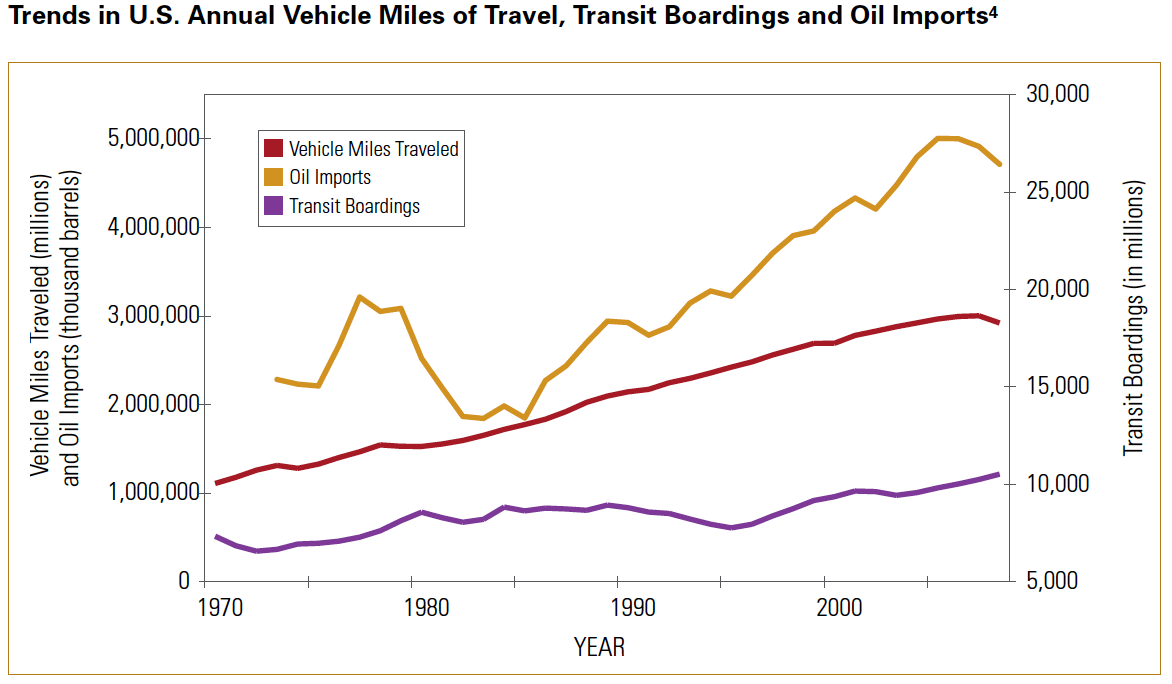MOBILITY CHOICE COALITION
Executive Summary
Oil’s virtual monopoly over transportation fuel coupled with limited economical and convenient alternatives for moving people and goods have made oil a strategic commodity and the lifeblood of the domestic and global economies. Passenger vehicles and light trucks account for more than 45 percent of U.S. oil demand. To reduce the strategic importance of oil, the United States must embark on a comprehensive effort to both break oil’s monopolistic grip on fuel for the light-duty vehicle fleet and open the market to vibrant competition among transportation options.
This report is about this second item, the often-overlooked role of transportation options, or mobility choice. These choices are absent in many neighborhoods even though there are fiscally responsible measures that would facilitate their delivery to more consumers. The paper projects the impact on oil demand of the policies outlined in the Mobility Choice Blueprint, a consensus document supported by a diverse coalition of security experts, energy experts, fiscal conservatives, and environmentalists.
Mobility choice can help provide flexibility both to individual drivers and to the nation as a whole. Choice involves both having a range of fuels to power the passenger fleet and having alternative options to driving to accomplish our daily rounds. Having options means not only that individuals will have greater choice, but also that the nation will have greater flexibility if confronted with oil price spikes or supply restrictions.
Reducing oil demand through fuel economy absent competitive markets—in transportation fuels, transportation modes, or both—serves to reduce the trade deficit as well as emissions, but is insufficient to change the strategic status of oil or the influence of the Organization of Petroleum Exporting Countries (OPEC), the oil cartel which controls 78 percent of world oil reserves. OPEC, striving to maximize the revenue of its members, has constrained production to the point where, despite accounting for the bulk of world oil reserves, it provides only 40 percent of global supply. When oil-consuming countries reduce net demand (or increase non-OPEC production), OPEC can respond by throttling down supply to drive prices back up. To fully de-fang this cartel, consumers must have viable choices that enable them to respond quickly to changes in oil prices, rendering the cartel’s machinations ineffective. Drivers can’t rapidly change the fuel economy of their vehicles, but with the right policies they could quickly change what fuel their vehicles use—and even how frequently they use those vehicles.
Now is the time to shift forward toward a future where Americans have real, viable transportation options.
Exploring Policies to Increase Competition Among Transportation Options
The first chapter of this paper reviews how public policies in the United States have promoted our oil-intensive transportation infrastructure. Whatever benefits these policies have generated, they have also tied our transportation system to oil. From the interstate highway system, to tax and zoning policies, federal, state and local governments have helped to lay the groundwork for our current transportation system and the importance of oil to our economy and way of life. The second chapter presents general principles that underlie a shift to a more economic and competitive transportation system. The third chapter offers 10 specific policy approaches that could open up America’s transportation market to more competition among modes and reduce oil demand by hundreds of millions of barrels per year.
Download full report (PDF): Taking the Wheel
About Mobility Choice Coalition
www.MobilityChoice.org
The Mobility Choice Coalition is a broad-spectrum alliance offering a fiscally responsible, free-market-oriented approach to expanding competition among ransportation modes for the purpose of reducing oil’s strategic importance.
Tags: Mobility Choice, Mobility Choice Coalition, Oil, OPEC







 RSS Feed
RSS Feed